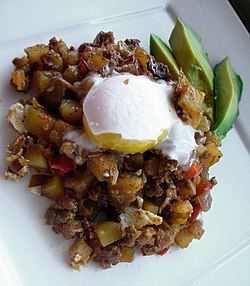B
- backwoods cooking
- A method of cooking without the use of utensils that commonly takes place in remote areas, often in combination with wild or conventional camping.
- baghaar
- A cooking technique used in Pakistani cuisine and Indian cuisine in which cooking oil is heated and spices are added to fry. The oil is then added to a dish for flavoring.
- bain-marie
- A method of cooking where a container of food is placed in or above boiling water in order to heat gradually or to keep warm. [5]
- baking
- barding
- Wrapping meat in fat prior to roasting. [6]
- barbecuing
- Cooking meat or fish slowly over a barbecue grill with indirect heat and smoke.
- basting
- Periodically pouring liquid over food as it roasts. [7]
- blanching
- A technique by which a fresh food such as a vegetable or fruit is briefly immersed in boiling water, removed after a timed interval, and then plunged into iced water or rinsed with cold running water (shocking or refreshing) to halt the cooking process.
- boiling
- braising
- A combination-cooking method that uses both wet and dry heats: typically, the food is first seared at a high temperature, then finished in a covered pot at a lower temperature while sitting in some (variable) amount of liquid (which may also add flavor).
- bricolage
- The preparation of a meal from whatever ingredients happen to be on hand.
- brine
- To soak a food item in salted water.
- broasting
- A method of cooking chicken and other foods using a pressure fryer and condiments.
- browning
- The process of partially cooking the surface of meat to help remove excessive fat and to give the meat a brown color crust and flavor through various browning reactions.






















